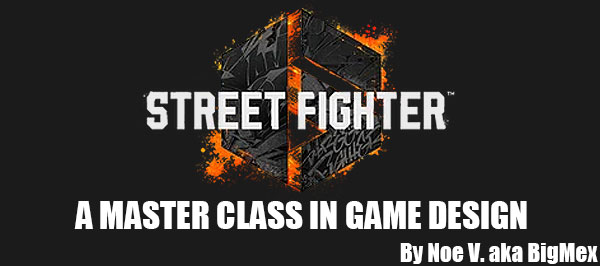
In the previous blog I talked about how Capcom learned how to create graffiti, and tattoo art for their games. In the ‘80s it was simply emulating the art style for the sake of pandering to the west. Years later it became an art form that they understood, and used to make their titles feel more authentic. I also talked about how important it was to have representation carry the elements of Hip Hop into the series. Kimberly was an amazing graffiti artist, and Jamie was an incredible b-boy. The studio had been trying to get a breakdance fighter into the series going back to the development of Street Fighter III, circa 1995-1996. In the earliest concept art this character literally stayed on their head the entire time. This dance type fighter would be dusted off, and revisited during the development of SFIV more than a decade later. It would be refined
in some early designs for King Cobra. Then dropped for the sake of pursuing a funny fatty. It wouldn’t be brought up again until Jamie.
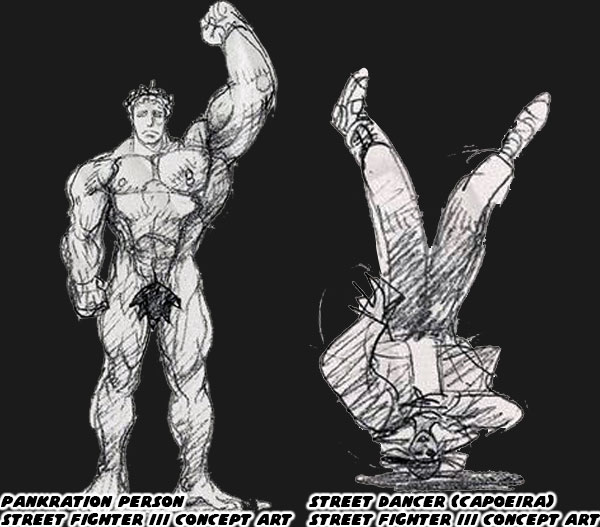
A breakdancer becoming an actual Street Fighter was an absurd idea, until it happened. It took a lot of time in development, and a team that understood the culture in order to make it fit within the context of the SF universe. There was another concept character in SFIII that seemed absurd at first, but again would require a team to figure out how this person would work. Moreover how this fighter would compliment the rest of the cast. The nude fighter was put on the back burner, but not the form of fighting. Pankration was among the oldest forms of mixed martial arts. The studio needed someone to bring the ancient art form into the modern world. That was essentially the role given to a strong woman. The team had just a rough idea for Marisa, make her a big, strong woman. Her form of fighting, her look, everything else would be filled in.
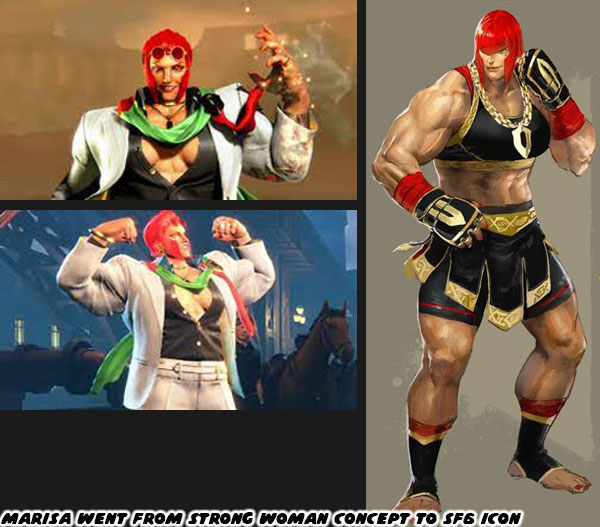
The studio had a solid template to work from when it came to big characters. Zangief was absolutely passionate about wrestling. It was something that Capcom could learn from, just as they took Chun-Li, and made an evil version out of her with Juri. Marisa was not evil, but would be equally passionate about pankration. She would give players a history lesson on the art in World Tour mode. She explained that fighters originally battled in the nude, and what a rush that must have felt like. She idolized everything about it to the point that she worshipped her ancestors, dressed like a modern gladiator, and wanted to share this passion with the world. Capcom was aware that to many players this type of ideation, and even character design seemed absurd. They countered it by making her absolutely sincere about her motivation.
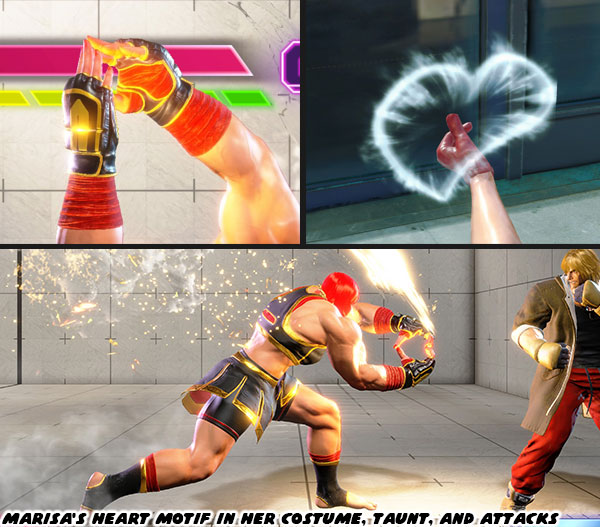
Despite her height, and muscular frame, she was still presented very feminine. She wore light makeup, along with a manicure, and pedicure into battle. She was even assigned a heart motif. Audiences that paid attention could see the heart symbol on the palms of her gloves, and also that when she did two-handed attacks she would make a heart symbol. Her taunt had her snapping her fingers, and making the
popular South Korean finger heart gesture.. Marisa was also a sensual character, reveling in the power of her femininity. In the arcade story mode she was even looking for a romantic partner. She kissed her invitations to do battle before posting them in various cities.
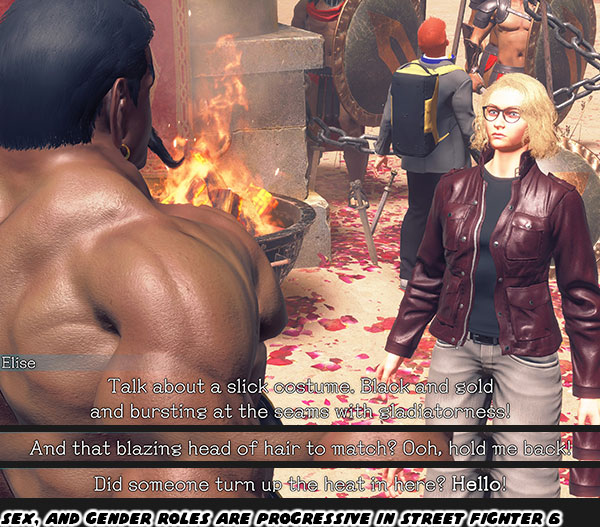
Capcom went all in on the progressive ideas in SF6. Marisa signaled in the game that she was bisexual. This was not done for the sake of a gag.
She was not played up for laughs like Rufus, or Hakan. She signaled that the studio was joining the modern world. Old tropes, biases, and bigoted ideas would no longer be part of the SF universe. It was clearly spelled out in Marisa’s dialogue in the World Tour, and what NPCs said about her. Both men, and women were swooning over her, and she reveled in the affection. This attitude could be seen in the design of other characters like Eternity. It was also apparent in the costumes that you give to your avatar. There was no distinction between male, and female clothing. Avatars could wear anything. Men could wear dresses, and have makeup, and women could be muscular, or fat, wear construction uniforms, tattoos, and have chain wrapped gloves. Not only that you could make your character look like a teenager, or an elderly person. There were no limitations to how you wanted to present yourself. The world had evolved greatly in 35 years. It was apparent at every step of the game.
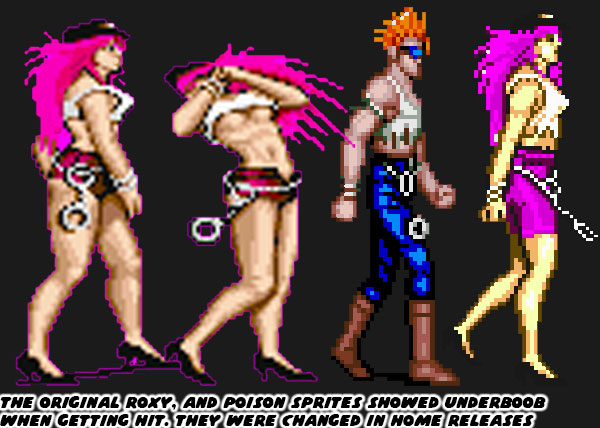
The SF6 developers were correcting past mistakes, and making their character designs more inclusive. A generation ago Poison Kiss was one of the most controversial characters in gaming. Her sexualized design of hot pants, high heels, and cropped tank top was deemed too risqué. It didn’t help that she showed underboob each time she was punched. This would be changed in home adaptations. First by replacing Poison with a punk named Sid, secondly by making her shirt, and shorts longer. The other thing that Capcom skirted the controversy was by saying that Poison was trans, he was a man, and therefore it was okay to punch a man. Capcom did this tongue in cheek because they saw how absurd USA censorship could be. Western studios seemed to love putting graphic violence in gaming, but drew the line at skin. It was sort of the opposite social approach in Japan where they were mostly okay with skimpy costumes, but didn’t want to depict blood, and guts violence. That attitude still persisted in Japanese society (and many other countries), however the SF6 development team was being more progressive with the story they wanted to tell.
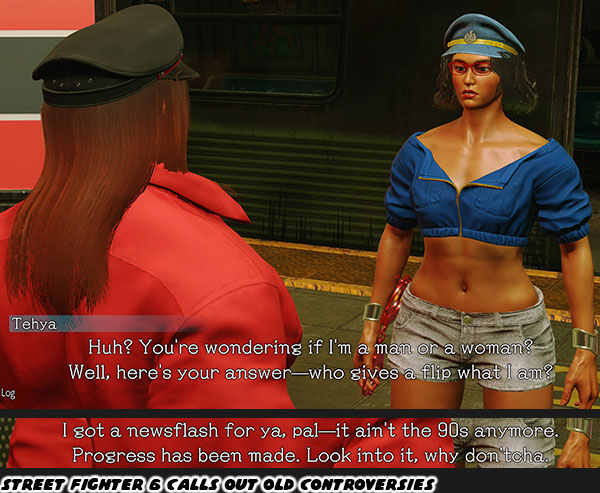
It was no more apparent that the new SF developers were turning the page on history with the dialogue from a Poison lookalike. The NPC Tehya said; “Huh? You’re wondering if I’m a man or a woman? Well, here’s your answer - who gives a flip what I am? I got a newsflash for ya, pal - it ain’t the 90s anymore. Progress has been made. Look into it, why don’tcha.” No notes, bravo writing from the localization team. The studio actually went above, and beyond in trying to correct past mistakes. We will look at how in the next blog. I hope to see you back for the next entry. If you are a long time fan of Final Fight, or Street Fighter then I would like to hear your impressions of SF6. If you have never played any game previously then tell me your experiences in the comments section please. As always if you would like to sponsor me
please visit my Patreon page and consider donating each month, even as little as $1 would help make better blogs and even podcasts!





![]()






![]()

Holy crap! I look away for a month and a 13 part series!
ReplyDelete